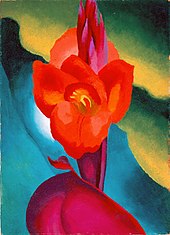
Georgia Totto O'Keeffe was an American modernist painter and draftswoman whose career spanned seven decades and whose work remained largely independent of major art movements. Called the "Mother of American modernism", O'Keeffe gained international recognition for her meticulous paintings of natural forms, particularly flowers and desert-inspired landscapes, which were often drawn from and related to places and environments in which she lived.

The Georgia O'Keeffe Museum is dedicated to the artistic legacy of Georgia O'Keeffe, her life, American modernism, and public engagement. It opened on July 17, 1997, eleven years after the artist's death. It comprises multiple sites in two locations: Santa Fe, New Mexico, and Abiquiu, New Mexico. In addition to the founding Georgia O'Keeffe Museum in Santa Fe, the O'Keeffe includes: the Library and Archive within its research center at the historic A.M. Bergere house; the Education Annex for youth and public programming; Georgia O'Keeffe's historic Abiquiu Home and Studio; the O'Keeffe Welcome Center in Abiquiu; and Museum Stores in both Santa Fe and Abiquiu. Georgia O'Keeffe's additional home at the Ghost Ranch property is also part of the O'Keeffe Museum's assets, but is not open to the public.
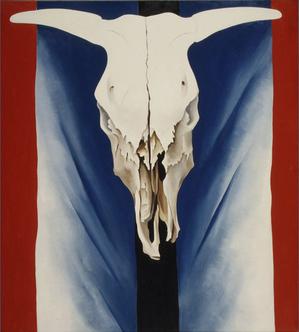
Cow's Skull: Red, White, and Blue is a painting by American artist Georgia O'Keeffe. It depicts a cow skull centered in front of what appears to be a cloth background. In the center of the background is a vertical black stripe, surrounded by two vertical stripes of white laced with blue. Outside are two vertical red stripes.
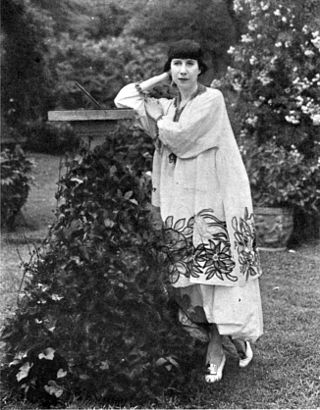
Florine Stettheimer was an American modernist painter, feminist, theatrical designer, poet, and salonnière.
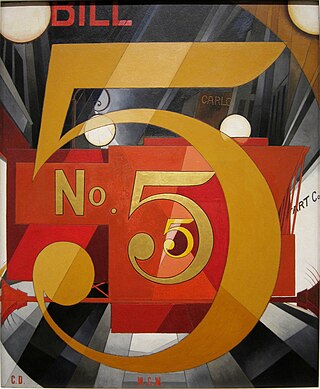
I Saw the Figure 5 in Gold, also known as The Figure 5 in Gold, is a 1928 painting by American artist Charles Demuth. It has been described as influenced by Futurism and Cubism.

Blue and Green Music is a 1919–1921 painting by the American painter Georgia O'Keeffe.
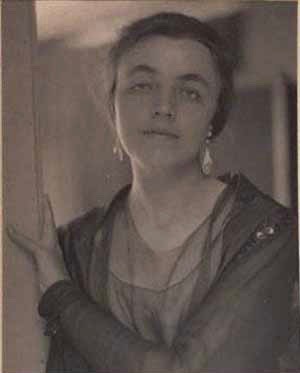
Katharine Nash Rhoades was an American painter, poet and illustrator born in New York City. She was also a feminist.

Marion Hasbrouck Beckett was an American painter.
Rebecca Salsbury James (1891–1968) was a self-taught American painter, born in London, England of American parents who were traveling with the Buffalo Bill Wild West Show. She settled in New York City, where she married photographer Paul Strand. Following her divorce from Strand, James moved to Taos, New Mexico where she fell in with a group that included Mabel Dodge Luhan, Dorothy Brett, and Frieda Lawrence. In 1937 she married William James, a businessman from Denver, Colorado who was then operating the Kit Carson Trading Company in Taos. She remained in Taos until her death in 1968.

Oriental Poppies, also called Red Poppies, is a 1927 oil-on-canvas painting by Georgia O'Keeffe. It is a close-up of two Papaver orientale flowers that fill the entire canvas.

O’Keeffe at the University of Virginia, 1912–1914 is an exhibition of watercolors that Georgia O'Keeffe created over three summers in the early 20th century at the University of Virginia. Shown at the Georgia O'Keeffe Museum in Santa Fe, New Mexico, the exhibit opened November 4, 2016 and ran through September 10, 2017. A year later, on October 19, 2018, the exhibition opened at the Fralin Museum of Art on the grounds of the University of Virginia, where it remained on display until January 27, 2019.
Light Coming on the Plains is the name of three watercolor paintings made by Georgia O'Keeffe in 1917. They were made when O'Keeffe was teaching at West Texas State Normal College in Canyon, Texas. They reflect the evolution of her work towards pure abstraction, and an early American modernist landscape. It was unique for its time. Compared to Sunrise that she painted one year earlier, it was simpler and more abstract.

The Flag is a painting by Georgia O'Keeffe (1918), that represents her anxiety about her brother being sent to fight in Europe during World War I, a war that was particularly controversial and dangerous due to its use of new modern weapons and tactics, like the machine gun, mustard gas, naval mines and torpedoes, high-powered artillery guns, and combat aircraft. Due to government restrictions on the freedom of speech included in the Espionage Act of 1917 the painting was not displayed until 1968. It is in the collection of the Milwaukee Art Museum.
The early works of American artist Georgia O'Keeffe are those made before she was introduced to the principles of Arthur Wesley Dow in 1912.

Black Iris, sometimes called Black Iris III, is a 1926 oil painting by Georgia O'Keeffe. Art historian Linda Nochlin interpreted Black Iris as a morphological metaphor for female genitalia. O'Keeffe rejected such interpretations in a 1939 text accompanying an exhibition of her work by writing: "Well—I made you take time to look at what I saw and when you took time to really notice my flower you hung all your own associations with flowers on my flower and you write about my flower as if I think and see what you think and see of the flower—and I don't." She attempted to do away with sexualized readings of her work by adding a lot of detail.

Georgia O'Keeffe created a series of paintings of skyscrapers in New York City between 1925 and 1929. They were made after O'Keeffe moved with her new husband into an apartment on the 30th floor of the Shelton Hotel, which gave her expansive views of all but the west side of the city. She expressed her appreciation of the city's early skyscrapers that were built by the end of the 1920s. One of her most notable works, which demonstrates her skill at depicting the buildings in the Precisionist style, is the Radiator Building—Night, New York, of the American Radiator Building.

The American artist Georgia O'Keeffe is best known for her close-up, or large-scale flower paintings, which she painted from the mid-1920s through the 1950s. She made about 200 paintings of flowers of the more than 2,000 paintings that she made over her career. One of her paintings, Jimson Weed, sold for $44.4 million, making it the most expensive painting sold of a female artist's work as of 2014.

Ida Ten Eyck O'Keeffe was an American visual artist known for oil paintings, watercolors, and monotypes. She was the younger sister of painter Georgia O'Keeffe.
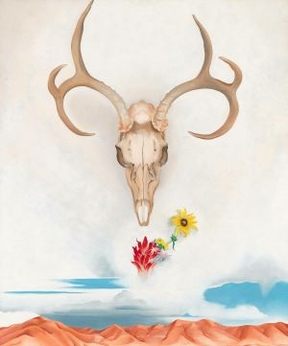
Summer Days is a 1936 oil painting by the American 20th-century artist Georgia O'Keeffe. It depicts a buck deer skull with large antlers juxtaposed with a vibrant assortment of wildflowers hovering below. The skull and flowers are suspended over a mountainous desert landscape occupying the lower part of the composition. Summer Days is among several landscape paintings featuring animal skulls and inspired by New Mexico desert O'Keeffe completed between 1934 and 1936.

Sky Above Clouds (1960–1977) is a series of cloudscape paintings by American artist Georgia O'Keeffe produced during her late period. The works were completed at her home and studio in Abiquiú and at her Ghost Ranch studio in Rio Arriba County, New Mexico. Only four paintings in the series share the same motif–a pink sky above the horizon with patches of cloudlets, or cloud streets below it, progressing from smaller to larger canvases. The motif was inspired by views from her airplane window during her frequent air travel in the 1950s and early 1960s when she flew around the world. Sky above Clouds IV, the fourth version in the shared motif of the series, is two meters high and seven meters wide. It is the largest painting ever created by the artist, accomplished at the age of 77 in the summer of 1965. Two of the paintings in the series are held by private collectors, while the rest are found in the National Gallery of Art, the Georgia O'Keeffe Museum, and the Art Institute of Chicago.


